Comparison of Psychiatrists and Psychologists in Clinical Practice
Abstract
OBJECTIVE: The authors compared data from psychiatrists and psychologists in California to determine whether long-standing differences in clinical practice remain after the introduction of managed care and other changes in mental service delivery. METHODS: Responses from practicing clinicians in California who participated in the 1998 National Survey of Psychiatric Practice and the 2000 California Survey of Psychological Practice were compared on items related to patient caseload, practice profile, and insurance or reimbursement arrangements. RESULTS: Data from 97 psychiatrists and 395 psychologists were available for the study. Psychiatrists reported spending more hours on most aspects of practice and working more total hours per week than psychologists. The weekly caseloads reported by psychiatrists included a greater percentage of persons treated for psychotic conditions than did the caseloads of psychologists. Psychologists reported that their weekly caseloads included a greater percentage of persons treated for anxiety disorders, personality disorders, and other disorders. Psychiatrists reported receiving a greater average payment for services from public insurance, and psychologists reported treating a greater average percentage of patients who did not have insurance coverage. Significant differences in income sources and fee arrangements were observed, and the net reported income of psychiatrists was nearly 80 percent greater than that of psychologists. CONCLUSIONS: Long-standing differences in clinical practice patterns remain between psychiatrists and psychologists despite managed care staffing arrangements and treatment strategies that streamline the practices of both provider groups. The significant income and wage differences between psychiatrists and psychologists may be partly due to supply dynamics of the mental health workforce that adversely affect psychologists.
Psychiatrists and psychologists represent two of the largest groups of clinicians providing mental health services (1). They provide specialized mental health treatment services and are reimbursed for these services through financing mechanisms not available to other providers (2). Nearly 70 percent of total outpatient specialty mental health expenditures in the 1980s were for psychiatrists and psychologists (3,4).
Important differences in clinical practice exist between psychiatrists and psychologists. Psychiatrists are licensed to prescribe medications, whereas psychologists generally are not. Psychologists conduct psychological and neuropsychological testing, the results of which are used in clinical settings for differential diagnosis and treatment planning and in judicial proceedings to award benefits, decide placements, or issue verdicts. Differences in the relative importance ascribed to biological, psychological, and social determinants of mental disorders have also been found between these provider groups (5). Research conducted in the 1980s and the early 1990s documented additional differences between psychiatrists and psychologists. Psychiatrists' patients were found to have more functional limitations and to receive more diagnoses of severe mental disorders than psychologists' patients (6). Psychologists were found to treat a clientele that was, on average, younger, more educated, and more likely to be employed (3,6).
These studies were undertaken before mental health financing and delivery was dominated by managed care delivery systems. In the past decade, psychiatry and psychology practices have undergone dramatic restructuring. Successive implementation of new benefits, authorization, and reimbursement schedules have reduced the duration of inpatient treatments and the scope and duration of outpatient psychotherapy and concurrently have increased medication management visits (7,8,9,10). Reductions have also been observed in the use of both psychiatrists and psychologists in health maintenance organizations (HMOs) and the use in carve-out firms of distinct patterns of referral to both provider groups on the basis of patient diagnoses (11,12). National survey data from psychiatrists provide indirect evidence that these changes in clinical practice may be unevenly distributed by providers' age, experience, and gender (13,14).
At the same time, annual salary surveys conducted among psychologists have shown that a majority attribute reductions in yearly income to managed care (15). To date, no comparative study has assessed whether previous differences in clinical practice remain, or the extent of service diversification within these provider groups in the aftermath of changes in financing, organization, and treatment provision. These comparative data would illustrate how each provider group has responded to changes in the mental health care delivery system.
In this study we compared the clinical practices of psychiatrists and psychologists in California on a series of practice profile, patient caseload, and financing dimensions. Demographic characteristics and characteristics of the health care market in California make examination of provider groups in that state of particular relevance. First, in 1999 California ranked 13th in terms of the percentage of persons with four or more years of college education and 17th in median family income, factors that have been shown to significantly influence the use of mental health services (16,17,18). These data suggest that the use of mental health services in California may not differentially influence the caseloads of psychiatrists and psychologists relative to those of providers in other states.
Second, California has one of the highest HMO concentrations in the nation; 50 percent of its eligible and insured population are covered under various HMO arrangements (19,20). Given the dominance of managed care, this pattern of HMO penetration may reflect future national trends. Finally, the California health care market includes a high proportion of both psychiatrists and psychologists per 100,00 population (21,22). A comparison of these provider groups may yield further evidence of how workforce supply dynamics differentially affect treatment patterns, workloads, wages, and income.
Methods
Data for psychiatrists in California who participated in the 1998 National Survey of Psychiatric Practice (NSPP) were used in this study. The 1998 NSPP was the second in a series of nationwide surveys conducted by the American Psychiatric Association (APA) to measure a range of clinical, organizational, and financing characteristics that shape contemporary psychiatric practice (21,23). The APA membership database, which is considered to represent a majority of practicing psychiatrists in the United States, was used in the sampling frame for the study. The 26-item survey was implemented through a series of personalized mailings, reminder postcards, and telephone calls.
Systematic sampling procedures were first used to select 1,200 participants. In addition, a random sample of 100 psychiatrists was drawn from each of three subgroups: African Americans, Hispanics, and psychiatrists younger than 40 years. The final sample of 1,500 psychiatrists represented the APA membership across key demographic and training variables. To adjust for the oversampling of psychiatrists from these three subgroups, a correction weight was constructed on the basis of a series of logistic regression models. A total of 1,076 valid surveys were received, for a response rate of 72 percent. Additional information about the sampling procedures, field methods, and weighting scheme as well as a description of the survey have been reported previously (21).
The 97 California psychiatrists represented nearly 10 percent of the 1998 NSPP sample. Preliminary comparisons of selected variables were made between the study sample and the larger 1998 NSPP sample. The subsample of NSPP psychiatrists in California was similar to the entire 1998 NSPP sample in age, mean number of years of clinical experience, and ethnicity but overrepresented male psychiatrists. The study sample was also similar to the 1998 NSPP sample in the proportion of psychiatrists who provided long-term psychotherapy, the proportion of psychiatrists who provided medication services without psychotherapy, and the mean rate of participation in managed health care plans.
The study sample reported a greater mean number of weekly hours in solo practice than the 1998 NSPP sample. The entire study sample of 97 California psychiatrists was engaged in clinical practice, which was defined as treating at least one patient a week.
Psychologists who were members of the California Psychological Association (CPA) were randomly selected to participate in the 2000 California Survey of Psychological Practice. The survey was pilot tested with a sample of CPA members and was revised on the basis of suggestions from the participants. Psychologists under the age of 40 years were oversampled to allow for differences between the CPA membership and the age distribution of all California licensed clinical psychologists. The final sample was weight adjusted to account for this oversampling. The survey was a 17-item questionnaire that included items to solicit demographic data on the CPA members. A description of the survey and additional information about its design and sampling procedures are reported elsewhere (24).
The sample consisted of 770 psychologists; 412 valid surveys were received, for a response rate of 54 percent. This sample of California psychologists was similar in mean age to all licensed psychologists in California. It was also similar in mean age, gender, and race or ethnicity to all California psychologists who at the time of the study were practitioner members of the American Psychological Association (25). The sample of psychologists used in this study (N=395) comprised only psychologists who were engaged in clinical practice, which was defined as treating at least one patient a week.
Psychiatrists and psychologists who participated in each respective survey provided information on caseload and practice profile characteristics, along with insurance or managed care participation rates. Items in this survey were worded in an equivalent or near-equivalent manner to the items in the NSPP to enable comparison.
Overall comparisons using analysis of variance were first performed on seven profiles of practice. For these comparisons, F tests were used to examine within-group variations versus between-group variations for each profile of practice. For each dimension of practice, between-group variation was significantly different than within-group variation. Individual t test comparisons of each aspect of clinical practice were then made between provider groups. Two-tailed tests were performed to control for type I errors; confidence intervals were set at 99 percent, and unequal variances between the two provider groups were assumed. Hourly wages for each provider group were calculated by dividing net reported income by the total number of weekly hours worked over a 46-workweek period. Median figures for net income, hourly wages, the proportion of total weekly hours spent in solo practice, and the total number of weekly hours worked for each provider group are presented for comparison. Standard errors were adjusted for the weighting and sampling design of each survey by using procedures for complex survey data implemented in STATA 6.0 (26).
Results
Demographic characteristics of the two groups are summarized in Table 1. The psychiatrists included a significantly greater proportion of male and nonwhite clinicians than the psychologists. The mean age and number of years of clinical experience were greater for the psychiatrists than for the psychologists.
The psychiatrists treated a significantly greater mean±SE number of patients per week (33.2±.18 compared with 21.7±.04, p<.001) and participated in more visits per week (30.3±.2 compared with 22.4±.02, p<.001) than the psychologists. Statistically significant differences were observed between the provider groups on nearly all other aspects of clinical practice as well. The results of these comparisons are presented in Tables 2 through 5. Because most of these differences are of little practical significance, only clinically significant differences are discussed below.
Discussion
This study presents a portrait of the practices of psychiatrists and psychologists since the introduction of managed care and recent changes in treatments. Previous studies have been restricted to samples of consumers or aggregate claims data from individual delivery systems in efforts to chart the distribution of patients by demographic and diagnostic categories and by the financing-arrangement patterns for both provider groups.
In contrast, we used provider data to chart typical weekly clinical practice patterns. This approach measures many of the essential elements of contemporary clinical practice. For the first time, comparative data are presented on the treatments, practice settings, health plan arrangements, income, and discounting practices of these providers. Each provider group is fairly representative of its larger respective national population on many demographic and practice characteristics. It is likely that these results generally represent the clinical practices of both provider groups.
Although statistically significant differences between psychiatrists and psychologists were evident for many dimensions of practice, many of those differences are of little clinical significance. This lack of clinical significance is due to each group's limited provision of services or limited participation in a service—for example, the proportion of time providing group psychotherapy per week—or because there were only minor differences between psychiatrists and psychologists for the services that represented important characteristics of each group's clinical practice, such as hours of direct patient care. Other differences, however, offer evidence of relevant trends in practice within and between the two groups of providers.
First, psychiatrists treat more patients, participate in more patient visits, and work more hours per week than psychologists. Clinical productivity appears to be greater among psychiatrists than psychologists, perhaps because psychiatrists treat patients who require more intensive treatment or because psychiatrists work in settings that produce larger caseloads, such as hospitals. This difference may be due to other characteristics of psychiatric practice, such as the fact that psychiatrists prescribe medications and schedule medication management visits, which allows them to treat more patients per hour.
Changes in the mental health care delivery system may also influence psychiatrists' workloads. On average, the psychiatrists in this study treated nearly a quarter of their patients with medications alone and treated nearly 60 percent of patients with an overall treatment plan that included medications. This pattern may reflect the impact of managed care policies that promote use of psychopharmacologic treatments alone or combined with treatment from other providers.
Characteristics of psychologists as a group may also affect their clinical activity, such as the higher proportion of women in the psychology field than in psychiatry. Previous studies have shown that female psychologists are more likely to work part-time than male psychologists (27). In addition, the female psychologists in this study were more likely to have had fewer years of clinical experience than the male psychologists. This characteristic of the sample might account for the differences we observed between psychologists and psychiatrists in important dimensions of practice, such as treatment settings and income sources. Given the growing dominance of women in the profession of psychology, the results of this study may represent practice trends nationwide.
The difference in productivity between the two provider groups may also reflect a longer duration of psychologists' traditional outpatient psychotherapy. The practice patterns of California psychologists in this study may reflect the adverse effects of competition among providers in a market that is saturated with mental health professionals (22,25). The emphasis of California psychologists on independent practice, their provision of few clinical services in hospital settings, and the fact that psychologists in California are not licensed to prescribe medications may magnify competition from other nonpsychiatrist mental health care providers.
Second, the results suggest that psychiatrists provide more specialized treatment than psychologists. More than three-quarters of the typical weekly treatments offered by psychiatrists fell into three categories: supportive psychotherapy, open-ended psychodynamic psychotherapy, and medication-only services. Two of these service categories, as presented in the 1998 NSPP, involve medication delivery, which is not provided by psychologists. In contrast, psychologists appear to provide more diverse treatments than psychiatrists. In addition, psychologists vary greatly among themselves in the types of treatment they offer. This variety in practice may exist because of the diverse theoretical and clinical perspectives that dominate contemporary clinical psychology.
However, although this sample of psychologists offers evidence of clinical diversity, the psychologists were largely independent practitioners with minimal reported affiliations with larger systems. Practice in solo and group settings accounted for nearly three-quarters of the psychologists' typical weekly practice locations. Many factors may account for this pattern, including training and personal choice, case mix, absence of hospital admitting privileges, and institutional treatment philosophies and clinical workforce patterns that influence psychologists' ability to diversify their practice settings. Evidence of this limitation in psychologists' clinical affiliations was found in a study of the staffing patterns in one large HMO, which showed reductions over time in the number of psychologists per 100,000 covered lives (11).
Third, our data on predominant financing sources for both psychiatrists and psychologists update earlier evidence of differences in financing sources between the two provider groups (3,6). The psychologists in this study had a higher proportion of patient self-payments among their weekly payment sources than did the psychiatrists. In addition, the psychologists provided nearly a quarter of their services to patients who did not have insurance coverage. This feature of psychological practice may be due to the types of treatments that psychologists provide, such as long-term dynamic or systemic therapies, which are reimbursed for only a portion of the duration of treatment.
Although psychiatrists' treatment settings—for example, public psychiatric hospitals—may be highly related to financing source and the treatment offered, the relationship between treatment, setting, and payment source appears to be less direct for psychologists. Future research may be able to assess whether psychologists' delivery of outpatient services in independent practice dictates the predominant payment sources or whether delivery of specific treatments to particular groups results in psychologists' reliance on particular payment sources and practice locations.
Finally, this study is the first to present comparative income data for both provider groups. Nationally, psychiatrists' income has been reported relative to that of other medical specialty groups, and income for different demographic groups has been reported among full-time psychiatrists from the larger 1998 NSPP sample (28,29). Income has been routinely reported among psychologists in full-time practice across disciplines and specialties (15,30). In this sample of California psychiatrists, reported net average income was similar to that reported in the entire 1998 NSPP sample of psychiatrists who worked full-time. The net median income of this sample ($120,000) was also equivalent to that of the entire 1998 NSPP (21).
This sample of clinical psychologists reported a net average income that was nearly $10,000 less than the figure most recently reported in the annual salary survey conducted by the American Psychological Association. However, if the comparison is restricted to full-time clinicians, the two figures are nearly identical. Median income for the sample ($65,000) was also equivalent to that reported in the annual salary survey (15).
What is striking in this study is the difference in hourly wages and income between psychiatrists and psychologists. The psychiatrists reportedly earned 60 percent more per hour and had an 80 percent higher annual net income than the psychologists. This income difference exists despite the fact that psychiatrists' caseloads include a sizeable percentage of persons with psychotic conditions, who presumably are unemployed, have public insurance that reimburses services at a lower rate than private insurance, or have incomes that may not be sufficient to cover this type of out-of-pocket expense.
The income differential between psychiatrists and psychologists is likely multifaceted and is probably due to such factors as the higher usual and customary fees of psychiatrists and the fact that the psychiatrists in this sample reported more clinical productivity, on average, than the psychologists. The results also suggest that although the two provider groups meet different clinical needs both for California's mental health delivery system and for the patients in that system, this division of labor results in considerable discrepancies in wages and net income.
Although psychologists treat a high proportion of self-pay patients and have a significant presence in mental health carve-out firms (12), market and organizational dynamics may be exerting significant downward pressures on their incomes. Nationwide, male psychologists and psychologists with more than ten years of clinical experience have more frequently reported decreases in annual salary that they attribute to changes in the health care system (30). The overall supply of psychologists in a given market may also suppress productivity and income.
One recent study developed several psychologist workforce scenarios using different ratios of psychologists to the treated population. The study estimated that the current supply of psychologists in many states, including California, greatly exceeds the workforce needs of managed care organizations (22). Evidence of this possible oversupply can be also found in data on the total growth of California licensed psychologists over time. While 11,000 California psychologists held a valid license and practiced their profession in California in 1999, only 5,340 held a license in 1990. This expansion in the psychologist workforce in California represents an 88 percent increase over a ten-year period (31). Furthermore, a study using these same data estimated that the supply of psychologists per 100,000 persons in the respondents' practice market had a larger negative effect on reported net income in dollar terms than did the psychologists' rate of participation in managed care (32).
Additional evidence may indicate how competitive pressures adversely affect psychologists' income. The percentage of patients who had discounted fees and the reported average discount per patient were greater for psychologists than for psychiatrists. It is possible that the observed wage and income differences are due to psychiatrists' professional dominance and status (33), clinical specialization, labor market supply dynamics, and diversification of treatment settings.
Some limitations of this study should be noted. First, the sample of psychiatrists was small, so the practice patterns we observed may not fully represent important characteristics of current psychiatric practice. The observed differences might not be generated—or might even be greater—in a larger sample of psychiatrists. The large proportion of male psychiatrists in our sample and the reported level of weekly time spent in solo practice may have produced different practice patterns than those that would be found in a sample with more female psychiatrists or more psychiatrists who spend less time in solo practice (34,35). Second, our data are cross-sectional and may not reflect important longitudinal trends. Third, the study was an exploratory, hypothesis-testing study subject to type I errors as a result of multiple statistical tests. Finally, particular epidemiological and demographic characteristics of the California population and characteristics of the health system in California may have affected these two provider groups in ways that are not evident elsewhere.
Conclusions
The results suggest that psychiatrists typically practice in a manner that results in diversity of treatment settings, case mixes, payment sources, and types of health plans. This diversity in psychiatric practice is not evident when studies use only data from particular payment sources or health plans. In contrast, the practice of psychology appears to be more narrow in setting and payment arrangements, which may adversely influence psychologists' productivity, income, and fee arrangements. Despite claims that changes in the health care industry are adversely affecting psychiatric practice, it appears from this study that the income of psychiatrists in California, a state with a large HMO penetration rate, is not significantly different from the income of psychiatrists in other states.
The lack of expansion in the psychiatrist workforce over the past two decades and the impact of that trend on the service role and status of the profession have been a subject of inquiry among health services researchers (9,34). The results of this study suggest that, perhaps as a result of this trend, psychiatric services remain in high demand. Psychologists, in contrast, may now be experiencing competitive pressures on their income and productivity as a result of the dramatic expansion of the psychologist labor force over the past two decades. This study has shown that long-standing differences between the clinical practices of these two provider groups remain despite the growth of managed care delivery systems.
Acknowledgments
This research was supported by grant MH-18828-13 from the National Institute of Mental Health to Dr. Pingitore. The authors acknowledge Harold A. Pincus, M.D., principal investigator of the 1998 National Survey of Psychiatric Practice.
Dr. Pingitore is affiliated with the Center for Mental Health Services Research at the University of California, Berkeley. Dr. Scheffler and Ms. Sentell are with the School of Public Health at the University of California, Berkeley. Dr. West is with the American Psychiatric Association's Practice Research Network in Washington, D.C. Send correspondence to Dr. Pingitore at 2020 Milvia Street, Berkeley, California 94720 (e-mail, [email protected]).
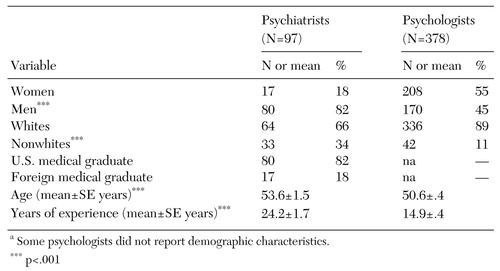 |
Table 1. Demographic characteristics of California psychiatrists and psychologists who responded to a survey on clinical practicea
a Some psychologists did not report demographic characteristics
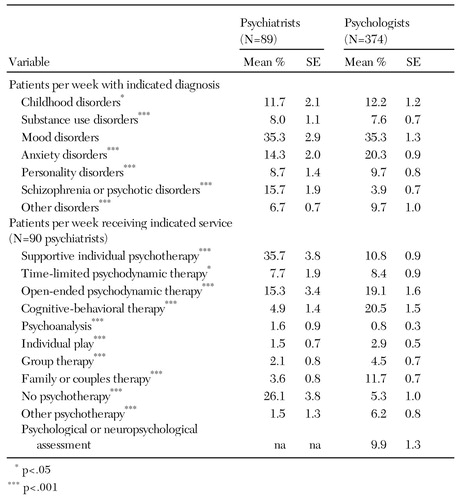 |
Table 2. Weekly caseloads and treatment profiles of psychiatrist and psychologists, in mean percentage of patients
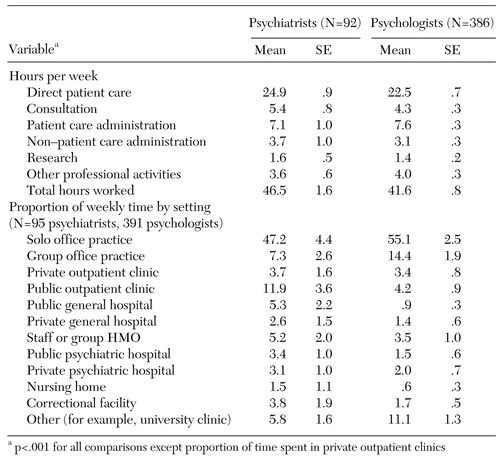 |
Table 3. Characteristics of practice and setting among psychiatrists and psychologists
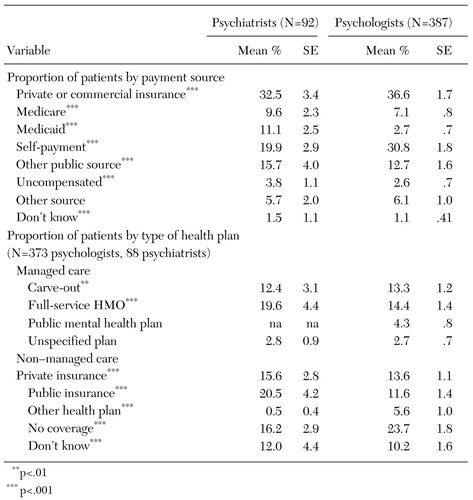 |
Table 4. Payment sources and health plan profiles of psychiatrists and psychologists, in mean percentages of patients
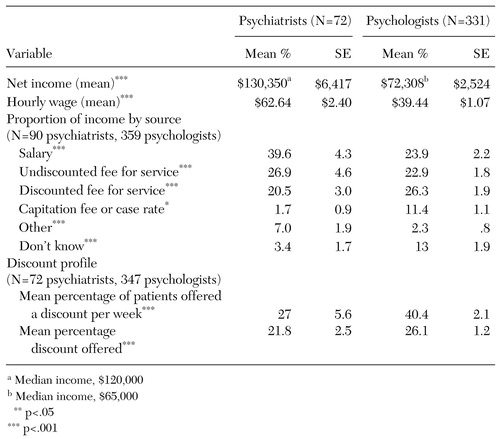 |
Table 5. Income, income sources, and discount profiles among psychiatrists and psychologists
1. Ivey SL, Scheffler RM, Zazzali JL: Supply dynamics of the mental health workforce: implications for health policy. Milbank Quarterly 76:25-58, 1998Crossref, Medline, Google Scholar
2. Rosenbach ML, Ammering CJ: Trends in Medicare part B mental health utilization and expenditures:1987-92. Health Care Financing Review 18:19-42, 1997Google Scholar
3. Taube CA, Burns BJ, Kessler L: Patients of psychiatrists and psychologists in office-based practice:1980. American Psychologist 39:1435-1447, 1984Google Scholar
4. McKusick D, Mark TL, King E, et al: Spending for mental health and substance abuse treatment:1996. Health Affairs 17(5):147-157, 1998Google Scholar
5. Wyatt RC, Livson N: The not so great divide? Psychologists and psychiatrists take stands on the medical and psychosocial models of mental illness. Professional Psychology: Research and Practice 25:120-131, 1994Crossref, Google Scholar
6. Olfson M, Pincus HA: Outpatient mental health care in nonhospital settings: distribution of patients across provider groups. American Journal of Psychiatry 153:1353-1356, 1996Link, Google Scholar
7. Buck JA, Umland B: Covering mental health and substance abuse services. Health Affairs 16(4):120-126, 1997Google Scholar
8. Buck JA, Teich JL, Umland B, et al: Behavioral health benefits in employer-sponsored health plans, 1997. Health Affairs 18(2):67-78, 1999Google Scholar
9. Stone AA: Paradigms, preemptions, and stages: understanding the transformation of American psychiatry by managed care, in New Roles for Psychiatrists in Organized Systems of Care. Edited by Sharfstein SS. Washington, DC, American Psychiatric Association, 1998Google Scholar
10. Pincus HA, Tanielian MA, Marcus SC, et al: Prescribing trends in psychotropic medications. JAMA 279:526-531, 1998Crossref, Medline, Google Scholar
11. Scheffler R, Ivey SL: Mental health staffing in managed care organizations: a case study. Psychiatric Services 49:1303-1308, 1998Link, Google Scholar
12. Sturm R, Klap R: Use of psychiatrists, psychologists, and master's-level therapists in managed behavioral health care carve-out plans. Psychiatric Services 50:504-508, 1999Link, Google Scholar
13. Zarin DA, Petersen BD, Suarez AS, et al: Sources of patient-care income, work settings, and age of male and female psychiatrists. Psychiatric Services 48:1387, 1997Link, Google Scholar
14. Zarin DA, Petersen BD, Suarez AS, et al: Practice settings and sources of patient-care income of psychiatrists in early, mid, and late career. Psychiatric Services 48:1261, 1997Link, Google Scholar
15. Williams S, Wicherski M, Kohout JL: Salaries in Psychology 1999: Report of the 1999 APA Salary Survey. Washington, DC, American Psychological Association, 2000Google Scholar
16. Current Population Survey: Income of Households by Race and Hispanic Origin. Washington, DC, US Census Bureau, 2000Google Scholar
17. Educational Attainment of the Population 25 Years and Over, by State. Washington, DC, US Census Bureau, 2000Google Scholar
18. Cleary P: The need and demand for mental health services, in The Future of Mental Health Services Research. Edited by Taube C, Hohmann A. Washington, DC, Department of Health and Human Services, 1989Google Scholar
19. InterStudy report provides county-level data on HMO enrollment, penetration, competition, and reimbursement rates. Digest of Managed Health Care 3(7):2-3, 1999Google Scholar
20. Cattaneo and Stroud, Inc: 2000 Statewide HMO Enrollment Study. Available at www.cattaneostroud.comGoogle Scholar
21. The 1998 APA National Survey of Psychiatric Practice: Public Use Data File Supporting Documentation. Washington, DC, American Psychiatric Association, 1999Google Scholar
22. Robiner WN, Crew DP: Rightsizing the workforce of psychologists in health care: trends from licensing boards, training programs, and managed care. Professional Psychology: Research and Practice 31:34-41, 2000Crossref, Google Scholar
23. Practice Research Network: How Has Psychiatric Practice Changed in the Past Ten Years? The 1998 NSPP Provides Some Answers. Washington, DC, American Psychiatric Association, 1999Google Scholar
24. Pingitore DP, Scheffler RM, Haley M, et al: Professional psychology in a new era: practice-based evidence from California. Professional Psychology: Research and Practice 32:585-596, 2001Crossref, Google Scholar
25. Characteristics of Doctoral-Level Practitioner APA Members in California. Washington, DC, American Psychological Association, 1999Google Scholar
26. STATA Corporation: STATA 6.0. College Station, Tex, Stata Press, 1999Google Scholar
27. Pion G, Mednick M, Astin H, et al: The shifting gender composition of psychology: trends and implications for the discipline. American Psychologist 51:509-528, 1996Crossref, Medline, Google Scholar
28. Goldberg JH: Doctor's earnings make a stride. Medical Economics 76:172-175, 178,183-186, 1999Medline, Google Scholar
29. Scheffler RM, Pincus HM, Pingitore DP, et al: Signals From the Market: The Impact of Managed Care on Psychiatrists' Income. Presented at the annual meeting of the Association for Health Services Research, Los Angeles, 2000Google Scholar
30. Williams S, Kohout JL, Wicherski M: Salary changes among independent psychologists by gender and experience. Psychiatric Services 51:1111, 2000Link, Google Scholar
31. Licensed Clinical Psychologists 1999. Sacramento, California Department of Consumer Affairs, Public Information Unit, 2000Google Scholar
32. Pingitore DP, Scheffler RM, Sentell T, et al: Psychologist supply, managed care, and the effects on income: fault lines beneath California psychologists. Professional Psychology: Research and Practice 32:597-606, 2001Crossref, Google Scholar
33. Abbott A: The System of Professions: An Essay on the Division of Expert Labor. Chicago, University of Chicago Press, 1988Google Scholar
34. De Titta M, Robinowitz CB, Moore WW: The future of psychiatry: psychiatrists of the future. American Journal of Psychiatry 148:853-858, 1991Link, Google Scholar
35. Dial TH, Grimes PE, Leibenluft E, et al: Sex differences in psychiatrists' practice patterns and incomes. American Journal of Psychiatry 151:96-101, 1994Link, Google Scholar



